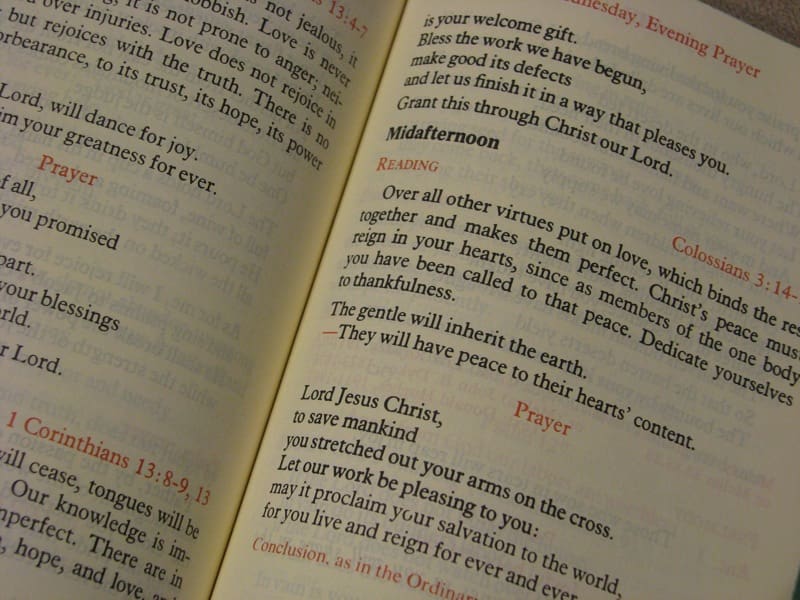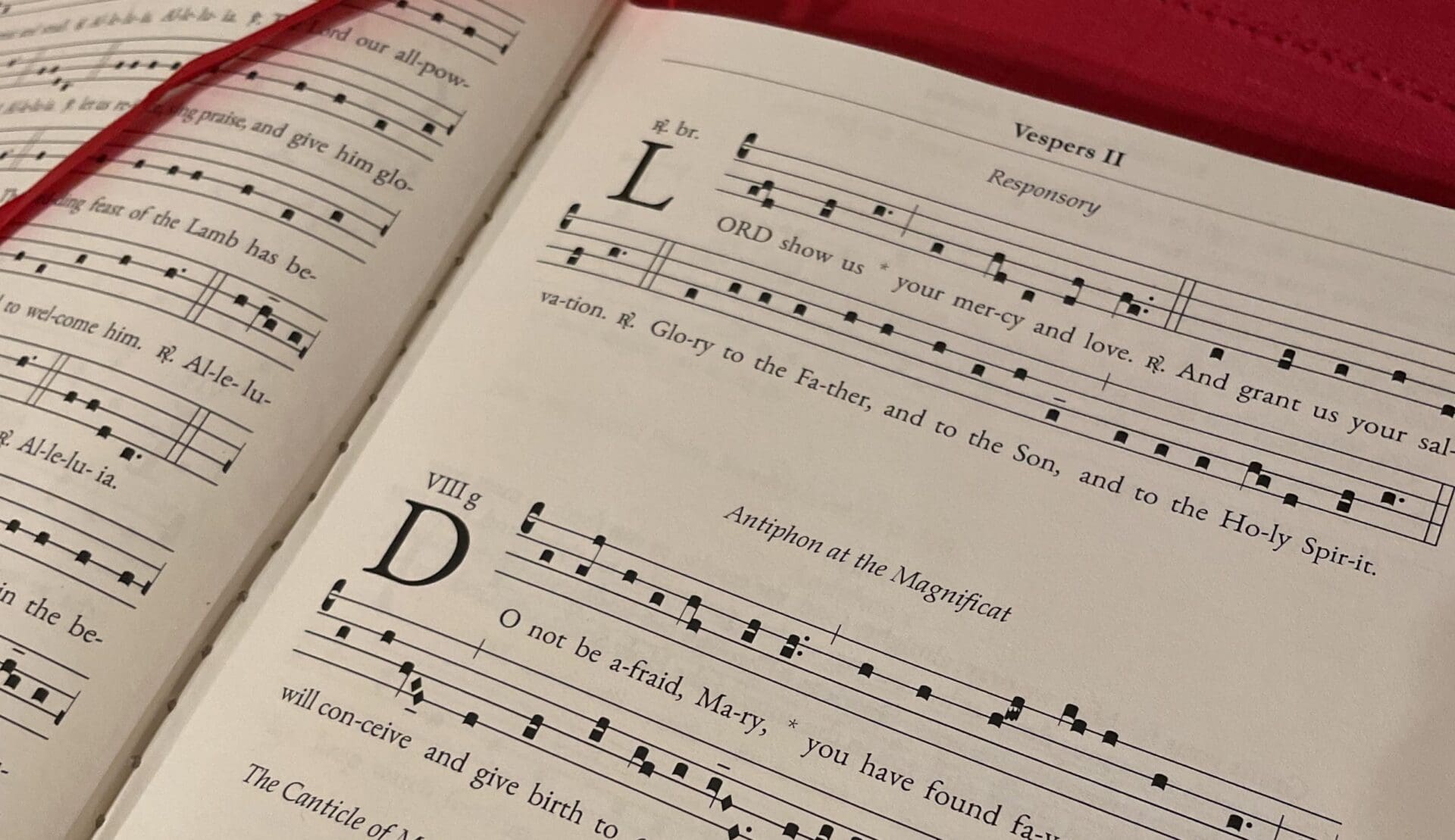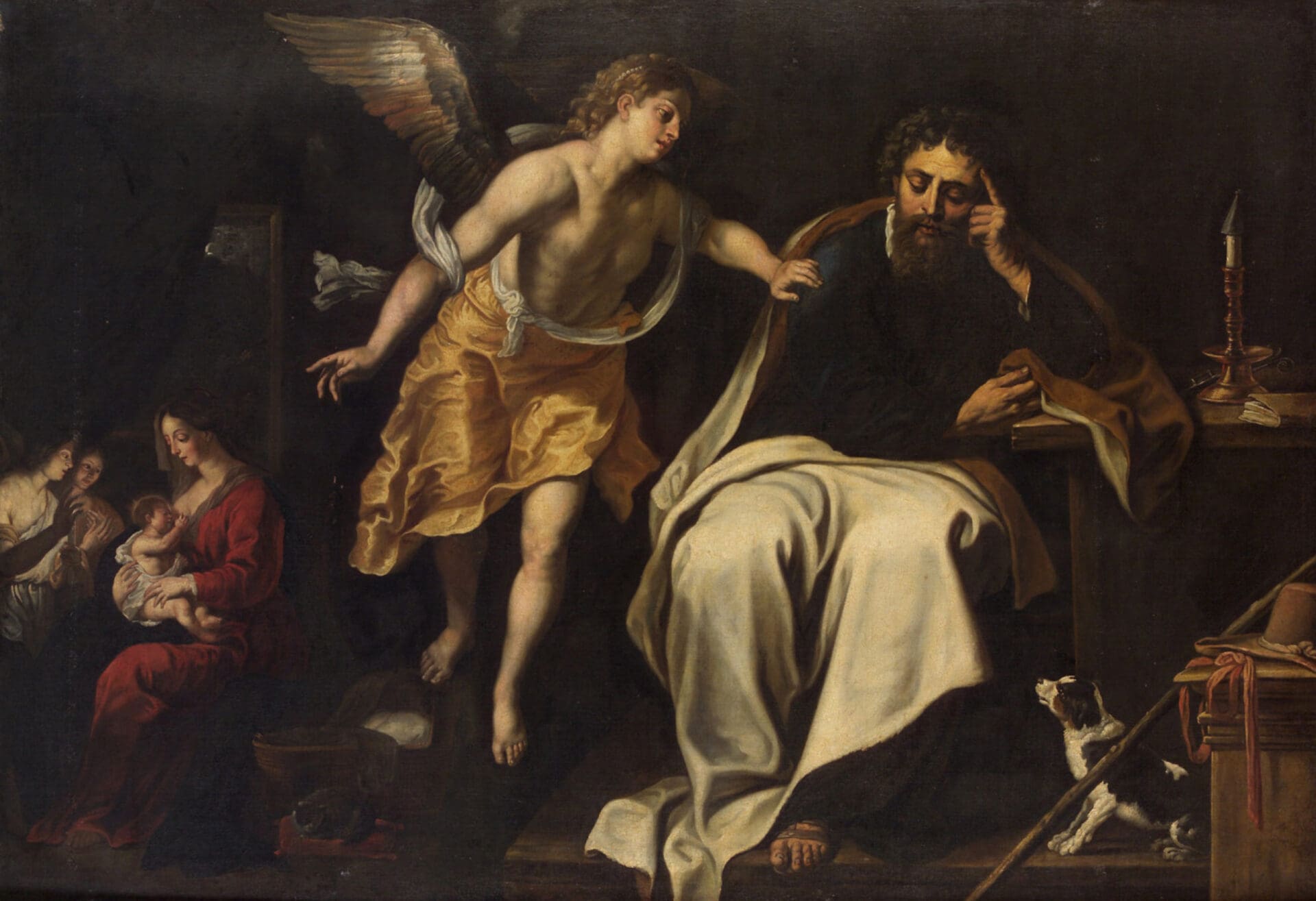In late 2020, the Abbey of Solesmes published Antiphonale Romanum I, but due to shipping difficulties related to the pandemic, only recently are these texts making their ways into the hands of eager lovers of Gregorian chant. The publication of this volume is a much more significant event than most Catholics would probably expect. Volume one completes a trio of texts which began with the publication of the Liber Hymnarius in 1983 and Antiphonale Romanum II in 2009. These three books provide the Gregorian notation for the antiphons, hymns, and responsories which are necessary to chant Lauds and Vespers from the modern Liturgy of the Hours on Sundays, feasts, and solemnities. These books are instrumental in implementing the vision of the Second Vatican Council regarding the reformed and restored Office.
The Fathers of the Second Vatican Council decreed in Sacrosanctum Concilium (SC) that “Pastors of souls should see to it that the chief hours, especially Vespers, are celebrated in common in church on Sundays and the more solemn feasts” (SC, 100). But there is an issue with this expectation. At the time that the Constitution was published, the traditional Breviarium Romanum was still in use. Chanting the office of Vespers on Sunday in a parish setting, for instance, was not too difficult because, with the exception of the Magnificat antiphon, the chants used at Sunday vespers hardly ever changed from week to week.
But the promulgation of the Liturgia Horarum in 1971 made this task exceedingly difficult for several reasons: (1) the introduction of the four-week psalter presented a constantly changing body of texts with different antiphons each week, (2) the hymns were more diverse, and (3) proper antiphons were introduced in seasons which before did not have proper texts. Yet, the most significant issue in attempting to chant the modern Liturgy of the Hours is that the texts of the Latin typical edition were not chosen to reflect the already-established body of Gregorian antiphons. In fact, an overwhelmingly large number of texts in the Liturgia Horarum are “new,” including a great number of hymns, which means that over half of the modern breviary makes use of liturgical texts for which there is not and has never been Gregorian/musical compositions.

Strictly speaking, parishes and religious houses which received the new Breviary in 1971 were faced with the impossible task of chanting an office which was not compiled with musical forms in mind. Communities across the world each had to decide how they were to proceed, especially communities where the chanted office had existed in custom for generations and formed part of the ethos of the liturgical life of the house. In some cases, communities wholesale rejected the new Breviary and continued to chant the older form, perhaps at least in hope that a musical form of the reformed Breviary would eventually be available. Other communities made use of the four-week psalter, but began creating their own books of antiphons which replaced the spoken texts of the Liturgia Horarum with pre-existing Gregorian chants of a similar text. Other communities sacrificed Gregorian chant and began to compose their own music in Latin or the vernacular, sometimes attempting to reflect the Gregorian modes and sometimes making use of modern forms of music.
Solesmes Sets the Standard
France’s Abbey of Solesmes, historically tasked with the duty to preserve the tradition of chant in the Church, quickly began work on producing a revised Antiphonale Monasticum, which is the equivalent chant book necessary for the sung office in the Monastic usage. These three volumes would form the basis for future editions of the sung version of the Liturgia Horarum even outside the monastery.
In this case, the Abbey was faced with a difficult question: should they simply compose new “neo-Gregorian” chants to reflect the texts in the reformed breviary, or should they substitute the breviary texts with pre-existing chants? As readers may expect, it was not a popular idea among Benedictine communities to simply throw out over a millennia’s worth of Gregorian tradition. Instead, a sort of compromise was made that allowed the substitution of Gregorian antiphons within the psalter, but the composition of neo-Gregorian melodies for the Magnificat and Benedictus antiphons texts where necessary. In regard to the hymns, it was decided that the new hymn texts would be assigned to pre-existing Gregorian melodies which made use of the same meter.
Parishes and religious houses which received the new Breviary in 1971 were faced with the impossible task of chanting an office which was not compiled with musical forms in mind.
In consultation with the Congregation for Divine Worship, this method of adaptation led to the publication of the Ordo Cantus Officii in 1983. The Ordo provides a schema where antiphons in the Liturgia Horarum may be substituted by pre-existing chants along with the manuscript source for each of those chants. At this point, it was now possible to have an agreed-upon body of chants which would apply to the modern breviary. But still there was a major issue: no book existed which provided all of these antiphons together. The Ordo itself makes reference to dozens of musical sources, sometimes including sources so obscure that only one or two European monasteries had copies of the chant. (It is worth noting that the Mass has its counterpart in the Ordo Cantus Missae, which forms the basis for the modern Graduale Romanum.)
Even with the publication of the Ordo and the Liber Hymnarius in 1983, it was still nearly impossible for the majority of religious houses to chant the modern office, let alone attempt to meet the Council’s demand that the office be celebrated solemnly in parishes. Those few communities which were convinced about the necessity of chanting the modern breviary were forced to produce leaflets for each chanted office which pasted together the necessary antiphons—as was, and in many cases still is, the practice of the Canons of the Basilica of St. Peter in Rome.
A significant moment came in 2008 when the Communauté Saint-Martin, a French community of parish priests, published Les Heures Grégoriennes. This three-volume set provides all the necessary chants according to the Ordo Cantius Officii 1983 in order to chant all the hours except the Office of Readings. Music and texts are provided in Latin, with a parallel French translation of the psalms, with marked accents allowing the singer to easily chant the text to the accompanying psalm tone.
The next year, Solesmes published its Antiphonale Romanum II which constituted the first “official” (that is, expert-made but not promulgated as a liturgical text) chant edition of the modern Liturgia Horarum. This volume covers the office of Vespers on Sundays, feasts and solemnities, and contains only minor differences from the chants selected in Les Heures Grégoriennes.

Unexpectedly, the Congregation for Divine Worship published a second edition of the Ordo Cantius Officii in 2015, which revised several of the antiphon selections of its predecessor. The need for this text arose in 2002 after Pope John Paul II introduced the three-year cycle of antiphons at the Gospel canticle. But the Ordo did not restrict these revisions to the newly introduced texts. Several changes were made in other places, including the four-week psalter. This made both Les Heures Grégoriennes and the Antiphonale Romanum II out of date, though in the case of the latter, only a few chants are now “incorrect.” The recent publication of the Antiphonale Romanum I reflects the 2015 Ordo, and therefore makes this volume the only “correct” edition available—though this text only covers the office of Lauds.
Work in Progress
As it stands, much work is still to be done. No official text has been published to cover memorials, ferial days, or any of the hours over than Lauds and Vespers (with the exception of Compline on Sundays, which is included as an appendix to the 2009 edition of the Liber Cantualis). It is worth mentioning that in regard to the Office of Readings, the task of providing music for this office is immense, especially considering that the official edition of the Nocturnale Romanum (which was made necessary by the 1911 reform of the breviary) was never published, having been in the process of creation at the time of the Second Vatican Council. Essentially, the clock ran out on the need for that text. (It is worth noting that the first published edition of the 1911 office of Matins was only made available in 2001 by a private German typesetter, Holger Peter Sandhofe. This text is out of print.) Solesmes did produce an interim edition for in-house use with the modern office, the Nocturnale Solesmense (2010). This paperback includes responsories and antiphons for the solemnity Vigils (the monastic version of Office of Readings). For the remainder of the year, it is the practice of the monks to simply chant the entire office on a straight-tone, and this custom is fairly common among houses within the Solesmes congregation.
All things considered, the publication of the Antiphonale Romanum I is both a major step forward, and also a sign of just how daunting a task it will be to provide chant editions for the entirety of the reformed Liturgy of the Hours. However, this conundrum also underscores the major difficulty in producing vernacular editions for the chanting of the office.
The publication of the Antiphonale Romanum I is both a major step forward, and also a sign of just how daunting a task it will be to provide chant editions for the entirety of the reformed Liturgy of the Hours.
Perhaps the most common available edition of the sung office in English is the Mundelein Psalter. This text, a joint venture of the University of Saint Mary of the Lake in Mundelein, IL, and Benedictine Father Samuel Weber, provides simple psalm tones for use in the psalter which can be applied both to psalm texts and antiphons alike, along with simplified hymn melodies. It is a popular edition among seminaries and religious houses, but while it provides a simple approach to the sung office in English, the Psalter cannot be said to be an English rendering of the true chanted office, as it treats the antiphons as simple addendums to the psalm texts, having them sung in the same manner according to a psalm tone. However, like in the Mass, the antiphons are properly liturgical moments in themselves. They are meant to provide a sort of meditative preface and conclusion to the psalm text, and therefore require the singer to linger over them with a through-composed melody.
Many modern composers and chant scholars have successfully provided English adaptations for the antiphons of the Mass, but doing so for the office is difficult both because of the unavailability of the music and because the translations themselves are, again, texts which largely do not have musical counterparts in their Latin original. So, the musician who performs the adaptation is left with either adapting a chant melody of one Latin text to an entirely different English text, or simply creating something new. Neither is really a satisfying option for those who are genuinely interested in chant tradition. The Trappist Abbey of Gethsemani in Kentucky produced its own office which uses modal settings of the texts from the Liturgy of the Hours, though without adherence to any Gregorian counterpart. A third option is for the composer to make translations of the Latin antiphons, but this itself is a shady area from the perspective of liturgical law, since clerics are bound to recite the official translation.
Text from Scratch
As a seminarian, I was faced with this conundrum in 2015 when the administration of Notre Dame Seminary in New Orleans approached me about producing a text for in-house use which would provide music for the chanted office of Vespers on Sundays, feasts, and solemnities. Prior to 2015, the seminary had made use of a collection of musical renderings of the Office which were of differing styles, and also did not allow for the true variety found in the modern Liturgy of the Hours. The desire with this text was to produce something that was reflective of the true tradition of the Gregorian office. The final edition, entitled the Notre Dame Vesperal, comprises 364 pages of English plainchant which are closely based upon the available Gregorian originals. The seminary has used this edition for all choral offices for the past six years.
In preparing this edition, I first had to do a significant amount of research using the 2015 Ordo Cantus Officii in order to determine which chants, in their Latin original, had identical or nearly-identical counterparts in the Latin edition of the office. Adaptations of these chants were made as closely as possible to the melodic original. However, for those antiphons which did not have a Gregorian original to match the spoken text, I searched for Gregorian antiphons which either had similar Latin texts or which were taken from a neighboring text in Scripture. The Latin antiphons of the office often make use of similar motifs across the year in order to invoke meditations among communities where the office is sung regularly. I tried to familiarize myself enough with these motifs in order to retain them. One I could mention is a motif found in the eighth mode on Marian feasts, particularly when the Incarnation is mentioned. The melody moves downward in rapid succession, which I always likened to the movement of the Holy Spirit descending into the womb of the Blessed Mother.
Regrettably, there are so many copyright laws which surround the publication of the Office that the seminary never sought to publish this text, so no editions are available for purchase. The Office is livestreamed weekly over seminary’s Facebook and YouTube pages, for those who are interested in hearing it.
Extraordinary Difficulty
In light of recent discussions surrounding the liturgical usages which preceded the 1970 reform, it is worth mentioning that it is entirely probable that at least among communities which use a Gregorian sung office, the desire to use the older, preconciliar books might likely be because no such counterpart edition is yet available in the reformed text. This discussion should underscore a difficulty in seeking a common expression of the Roman Rite.
Until all of the liturgical books of the reformed liturgy are available, it is hardly possible to expect people to wholesale give up the books they have, especially those in communities which have existed for centuries and which thrive on the tradition of the chanted office. Meeting the standard proposed by the Fathers of the Council in Sacrosanctum Concilium 100 will not be possible until the necessary books actually exist. AB
The Chant Books for the Modern Liturgy of the Hours:
Ordo Cantus Officii: A schema or outline providing references to manuscript sources and page numbers for each Gregorian chant necessary to sing the entire Liturgy of the Hours. Promulgated by the Congregation for Divine Worship first in 1983, and then revised in 2015.
Antiphonale Romanum I: Provides the Gregorian chants necessary to sing the office of Lauds (Morning Prayer) on Sundays, solemnities, and feasts. Published by the Abbey of Solesmes, 2020.
Antiphonale Romanum II: Provides the Gregorian chants necessary to sing the office of Vespers (Evening Prayer) on Sundays, solemnities, and feasts. Published by the Abbey of Solesmes, 2009.
Liber Cantualis: A small book of miscellaneous chants to be used at common Masses, Offices, and devotions, including the chants necessary for Compline (Night Prayer) on Sundays and solemnities. Published by the Abbey of Solesmes in 1995.
Liber Hymnarius: Provides the Gregorian notation for all the hymns and invitatories of the Liturgy of the Hours. Published by the Abbey of Solesmes, 1983.
Antiphonale Monasticum: A collection of chants for the daytime hours of the office according to the Monastic usage. Published by the Abbey of Solesmes, 2007.


